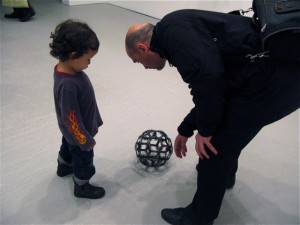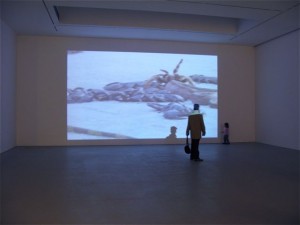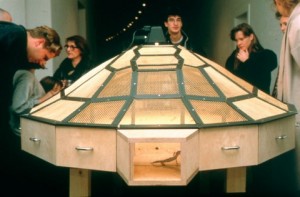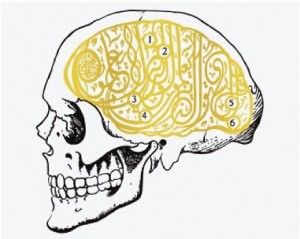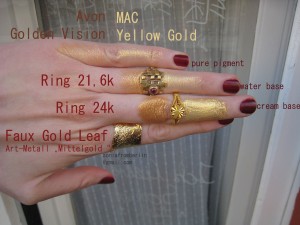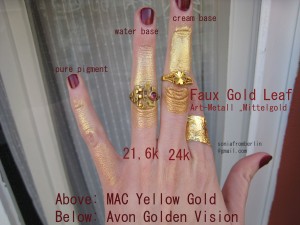I watched The Royal Tenenbaums (2001, director+screenplay Wes Anderson) lately again. At Minute 27:27 in, the picture I attached below hangs in the hall where head of the family, Royal Tenenbaum, meets his grown-up kids after 17 years again (it is not visible in the beginning, when he talks to his kids Etheline and him decided to live seperately).
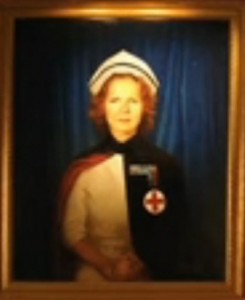
I tried to find that picture through google images, my first wild guess was Florence Nightingale. Obviously she isn’t. Maybe one of the film crew members stood for that. If anyone knows more about that picture and the production of the picture, feel free to comment, I’m curious.
The picture is introduced by Royal as their grandmother, Helen O’Reilly Tenenbaum, buried in (fictional) Maddox Hill Cemetery, lot 109, lived 1899- 1954, tombstone inscribtion: the salt of the earth. The Tenenbaums visit her grave 35:05 in.

Royal’s mother’s name and her living dates might be referrring to one of the victims of Mamie Cadden, a Dublin based Irish midwife, also backstreet abortionist and murderer. There is at least one RTÉ feature also featuring the controversial case.
An Article of 2005 from the Independant points out,
„The glamorous blonde nurse [Cadden], who drove a red MG and lived the high life while working as a backstreet abortionist in Dublin, has always been remembered for the one [emphasis my me] operation that went wrong. When impoverished alcoholic mother-of-six Helen O’Reilly turned to Cadden for help with an unplanned pregnancy, the nurse accepted Helen’s £15 to perform the abortion, despite being well into her 60s and in poor health. While syringing Jeyes Fluid into the 33-year-old’s womb, Cadden stalled and accidentally injected a bubble of air which entered O’Reilly’s blood and killed her. Cadden stood trial for the murder, was convicted and sentenced to death, but a year later was found insane and died two years later in 1959 in the Dundrum Mental Hospital. According to his book Mamie Cadden, Backstreet Abortionist, Kavanagh says that the nurse was an angel of hope to thousands of women who went to her for help.“
So portraying Helen O’Reilly Tenenbaum as a nurse might be a hint to Mamie Cadden, who really was a nurse. Going deeper, the death date as 1954 and the tombstone inscription point to the movie of that very year, Salt of the Earth (1954), which was blacklisted and highly discussed as it brang in radical communist points of view. It is also the closing song of the Rolling Stones album Beggars Banquet (1968). The album Between the Buttons (1967) can be seen in Richie’s tent in the movie, too; and Wes Anderson seems to like to include The Rolling Stones in his movies in general.
It is very interesting that this minor detail in the movie unfolds so massively.
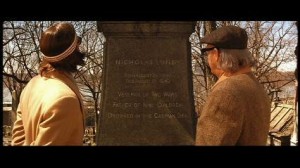
The second grave Royal and Chas visit, at 36:29 in, is from Nicholas Lundy. The tombstone reads: Born August 24, 1889; Died August 15, 1949; veteran of two wars; father of nine children; drowned in the caspian sea. It is very easy to find out who that one is through simply googling the name:
Here’s a little fun fact for you. I am Nicholas Lundy and that gravestone you see in „The Royal Tenenbaums“ was designed by a friend who was the Art Director on the movie (I’m also a Production Designer/Art Director). He called me up one day and said „I hope you don’t mind, but there’s a huge Obelisk with your name on it in Grant Park“) So FYI, Nicholas Lundy is very much alive and also likes his colour.
-nikwhey Posted Jul 30, 2008
The non-fictional Nicholas Lundy was at no point involved directly in the movie The Royal Tenenbaums. The Art Director of The Royal Tenenbaums was Carl Sprague. They know each other from working together as both assistant art directors in Addicted to Love (1997) and Amistad (1997), where Sprague was set designer and Lundy assistant art director for the East Coast. The mentioned Grant Park (probably of Chicago?) is not listed in the IMDb filming locations but Trinity Church Cemetery of Manhattan, New York City, is.
The third grave Royal is visiting, is where he meets his son Richie and his grandchildren Uzi and Ari, at minute 38:18 in the movie.
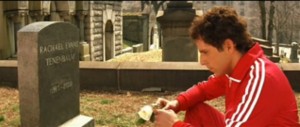
It is the grave of the deceased wife of Richie, Rachael Evans Tenenbaum, lived 1965-2000. She died in a plane crash „one year ago“. Her death date is the first one pointing out that the fictional time in the movie is according to contemporary time indeed, opposed to the setting and the characters, pointing to be set somewhere in the seventies. Royal revisits the grave of Rachael later alone again (89:10), after Richie denied his sons to follow Royal for „grabbing a couple of burgers and hittin‘ the cemetery“.
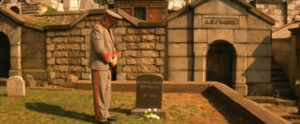
At last, there is Royal’s own burial and graveyard. At 101: 26, the hearse is driving into the graveyard.
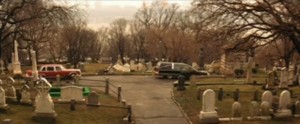
Royal’s tombstone reads: Royal O’Reilly Tenenbaum; 1932-2001; died tragically rescuing his family from the wreckage of a destroyed sinking battleship. Again, as with Rachael, his death year is the same as the release of the movie.
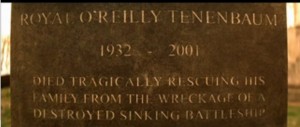
The most interesting part is that the tombstone of Royal is located outside the fenced area of the Tenenbaums; while Royal’s body and the casket are placed inside, close to his mother. The light tombstone in the background is Helen’s. This practice is reminding me of the christian donkey funeral, as written in Jeremiah 22:19.
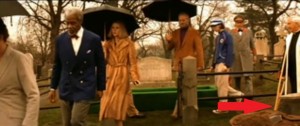
Again, the lot number 109 is shown when Pagoda closes the fence entry door with crest and arms of the Tenenbaums.
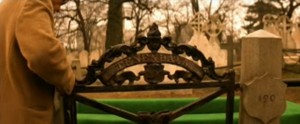
The movie ends with that scene. I am not sure about the fence, but I have not seen that before; it is either mausoleum or a common lot but fences right in the middle of a graveyard? Also, the tombstone outside/casket inside thing is somewhat irritating. Those might have been choices from the director purely based on filming obligation he had to meet from Trinity/St Paul’s.
The release of the movie The Royal Tenenbaums was Dec 14th, 2001- only four weeks after 9/11. Trinity Church Cemetary was at that time closed to the public and covered in fragments of the twin towers.
